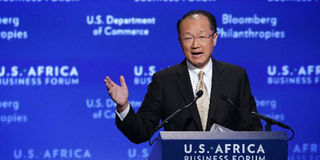World Bank foresees bright Kenyan future

World Bank President Jim Yong Kim speaks in a session during the U.S. Africa Leaders Summit at the Mandarin Oriental Hotel August 5, 2014 in Washington, DC. A World Bank report released January 8, 2016 predicts that Kenya will again be amongst the top dozen performing countries in the continent. PHOTO | AFP
What you need to know:
- The report, released Thursday predicts that the country will again be amongst the top dozen performing countries in the continent, in terms of growth and that rates will increase to 6.1 per cent in both 2016 and 2017.
LONDON
Kenya is again set to be one of the fastest-growing economies in Africa, although its growth rate of 5.7 per cent is still below East African neighbours Tanzania and Ethiopia according to the latest World Bank Global Economic Prospects for 2016.
The report, released Thursday predicts that the country will again be amongst the top dozen performing countries in the continent, in terms of growth and that rates will increase to 6.1 per cent in both 2016 and 2017.
Growth predictions are above that of Uganda (5 per cent) but below Tanzania (7.2), Rwanda (7.6) and Ethiopia on a staggering 10.2 per cent but still well above average rates in Africa and other emerging economies.
The World Bank says that sub-Saharan Africa as a whole is forecast to grow by 4.2 per cent in 2016 from 3.4 per cent in 2015 as commodity prices stabilise.
It says that economic activity “will vary across sub-Saharan Africa, with consumption growth remaining weak in oil exporting countries as fuel costs rise, while lower inflation in oil importing countries helps boost consumer spending.”
South Africa has one of the weakest levels of growth on 1.4 per cent growth up just 0.1 per cent in the previous year.
The report says that weak expansion among major emerging markets will weigh on global growth in 2016, but economic activity should still pick up modestly to 2.9 per cent from 2.4 per cent in 2015.
“Simultaneous weakness in most major emerging markets is a concern for achieving the goals of poverty reduction and shared prosperity because those countries have been powerful contributors to global growth for the past decade,” the report says.
Moreover, a lack of growth in developing countries “poses a threat to hard-won gains in raising people out of poverty,” the report warns.
“More than 40 per cent of the world’s poor live in the developing countries where growth slowed in 2015,” said World Bank Group President Jim Yong Kim.
Global economic growth was less than expected during last year when falling commodity prices, flagging trade and capital flows, and episodes of financial volatility sapped development activities.





